Shepherd's Bush
| Shepherd's Bush | |
|---|---|
.jpg) Shepherd's Bush Green | |
 Shepherd's Bush Shepherd's Bush shown within Greater London | |
| OS grid reference | TQ235798 |
| • Charing Cross | 4.9 mi (7.9 km) E |
| London borough | |
| Ceremonial county | Greater London |
| Region | |
| Country | England |
| Sovereign state | United Kingdom |
| Post town | LONDON |
| Postcode district | W12 |
| Dialling code | 020 |
| Police | Metropolitan |
| Fire | London |
| Ambulance | London |
| EU Parliament | London |
| UK Parliament | |
| London Assembly | |
Shepherd's Bush is a district of west London, England, within the London Borough of Hammersmith and Fulham 4.9 miles (7.9 km) west of Charing Cross, and identified as a major metropolitan centre in the London Plan.
Although primarily residential in character, its focus is the shopping area of Shepherd's Bush Green, with the Westfield London shopping centre a short distance to the north. The main thoroughfares are Uxbridge Road, Goldhawk Road and Askew Road, all with small and mostly independent shops, pubs and restaurants. The Loftus Road football stadium in Shepherd's Bush is home to Queens Park Rangers. In 2011, the population of the area was 39,724.
The district is bounded by Hammersmith to the south, Holland Park and Notting Hill to the east, Harlesden to the north and by Acton and Chiswick to the west. White City forms the northern part of Shepherd's Bush. Shepherd's Bush comprises the Shepherd's Bush Green, Askew, College Park & Old Oak, and Wormholt and White City wards of the borough.
Geography
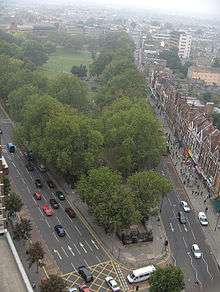
The area's focal point is Shepherd's Bush Green (also known as Shepherds Bush Common), a triangular area of about 8 acres (3 ha) of open grass surrounded by trees and roads with shops, with Westfield shopping centre to its north.
The Green is a hub on the local road network, with four main roads radiating from the western side of the green and three roads approaching its eastern apex, meeting at the large Holland Park Roundabout. This position makes it an important node of the bus network, with eighteen bus routes arriving there. It is also served by five London Underground stations (see Transport below): Shepherd's Bush and White City both on the Central line, and Shepherd's Bush Market, Goldhawk Road and Wood Lane all on the Hammersmith & City line.
To the east, Shepherd's Bush is bounded by the physical barrier of the West London railway line and the grade-separated West Cross Route (part of the aborted 1960s London Motorway Box scheme); the Holland Park Roundabout and the small Addison Bridge to the south are the only ways to cross this barrier from Shepherds Bush.
Most of the areas to the east of the barrier differ significantly in character, being associated with the more affluent Holland Park and Notting Hill; although the Edward Woods Estate just to the north-east of the roundabout is part of and is managed by the London Borough of Hammersmith & Fulham.
Commerce
Commercial activity in Shepherd's Bush is now focused on the Westfield shopping centre next to Shepherd's Bush Central line station and on the many small shops which run along the northern side of the Green.
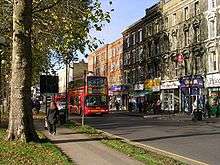
Originally built in the 1970s with a rooftop car park and connecting bridge to the station, the older West 12 Shepherds Bush shopping centre was significantly redeveloped in the 1990s. The bridge was removed, and the centre now houses several chain stores, a 12-screen cinema, gym, pub, restaurants, a medical practice and a supermarket.[1]
The small shops continue along Uxbridge Road to the west for some distance, and another set of shops and restaurants line Goldhawk Road from the Green to the southwest. Many of these establishments cater for the local ethnic minority communities (see Demographics).
Running parallel to, and partly under, an elevated section of the Hammersmith & City line there is a large permanent market, the Shepherd's Bush Market, selling all types of foodstuffs, cooked food, household goods, clothing and bric-à-brac.
The Westfield Group (with Hausinvest Europa) opened a shopping centre in October 2008.
Office buildings
As well as the offices within the BBC TV Centre on Wood Lane, opposite this is Network House, 1 Ariel Way, a 20,000 sq ft (2,000 m2) building that was let by Frost Meadowcroft on behalf of Westfield to Zodiak Entertainment in September 2009[2] and in Rockley Road is the 160,000 sq ft (15,000 m2) Shepherds Building where Endemol another TV company are based and where Jellycat, a soft toy company, relocated their head office to in February 2010.[3] The same building also houses Escape Studios, a digital art school providing computer graphics training for the visual effects industry in London.[4]
Residential
The residential areas of Shepherd's Bush are primarily located to the west of the Green, either side of Uxbridge Road and Goldhawk Road to the southwest, and about as far as Askew Road in the west. Much of the housing in this area consists of three- or four-storey terraces dating from the late 19th century, and subsequently divided up into small flats.[5]
Shepherd's Bush is also home to the White City Estate, a housing estate that was originally constructed in the 1930s and further extended after the war in the early 1950s. It was built on the site of the grounds of the 1908 Franco-British Exhibition and close to the White City Stadium and has given its name to the northern part of Shepherd's Bush which is now better known as White City.
History
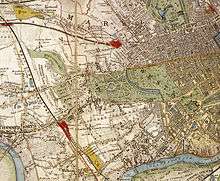
Origins
The name Shepherd's Bush is thought to have originated from the use of the common land here as a resting point for shepherds on their way to Smithfield Market in the City of London. An alternative theory is that it could have been named after someone in the area, because in 1635 the area was recorded as "Sheppard's Bush Green".
Evidence of human habitation can be traced back to the Iron Age. Shepherd's Bush enters the written record in the year 704 when it was bought by Waldhere, Bishop of London as a part of the "Fulanham" estate.[6]
19th century
A map of London dated 1841 shows Shepherd's Bush to be largely undeveloped and chiefly rural in character, with much open farmland compared to fast-developing Hammersmith. Residential development began in earnest in the late 19th century, as London's population expanded relentlessly. In 1904 the Catholic Church of Holy Ghost and St Stephen, built in the Gothic style with a triple-gabled facade of red brick and Portland stone, was completed and opened to the public.[7]
20th century
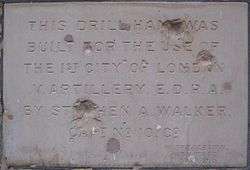
Like other parts of London, Shepherd's Bush suffered from bomb damage during World War II, especially from V-1 flying bomb attacks (known as "doodlebugs" or "buzzbombs"), which struck randomly and with little warning.[8]
On 13 April 1963 The Beatles recorded their first-ever BBC Television broadcast at Lime Grove Studios in Shepherd's Bush. The group returned in 1964 for a further recording. Lime Grove Studios was demolished in 1994 to make way for residential accommodation.[9]
More recently, the White City bus station is housed in the redeveloped Dimco Buildings (1898), Grade II listed red brick buildings which were originally built in 1898 as a shed for a London Underground power station.[10][11] The Dimco buildings were used as a filming location for the ‘Acme Factory’ in the 1988 film Who Framed Roger Rabbit?, and later served as the interior of the British Museum in The Mummy Returns.[12]
Demographics
Significant communities of travellers from Australia and New Zealand exist in Shepherd's Bush. Street names in the area suggest links to South Africa but these were inspired by places and personalities from the Boer War or by their proximity to the former position of the South Africa Pavilion in the White City exhibition area. There is a Polish community, with a community centre in nearby Hammersmith. There are also Somali, West Indian, Syrian, Lebanese, Iranian, Irish, Algerian, Moroccan and Afghan communities that exist in Shepherd's Bush.
Transport
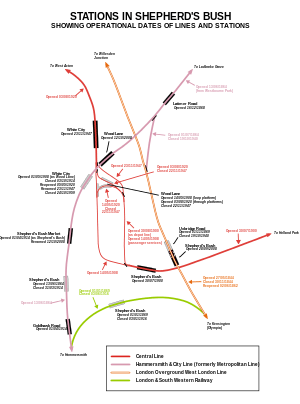
The common itself is served by five London Underground stations. Shepherd's Bush station, on the Central line at the eastern apex of the common, is the busiest, whilst Shepherd's Bush Market station on the Hammersmith & City line is about 650 yards to the west (near the north-western corner of the green). The third station, Goldhawk Road station on the Hammersmith & City line, serves the south-western corner of the green. The primarily residential area to the west of the common, also recognised as part of Shepherd's Bush, is also served by White City and Wood Lane. This area of London is also served by eighteen bus routes.
The opening of the Westfield London shopping centre in 2008 led to the development of two new transport hubs for the area. The northern interchange consists of White City station on the Central line, White City bus station and Wood Lane station on the Hammersmith & City line. The two stations are a short walk apart.
The "southern interchange", comprises another new bus station, the redeveloped Central line station and the new Shepherd's Bush railway station served by London Overground and Southern on the West London line. The new station is approximately in the same location as the former Uxbridge Road station which closed in 1940. The opening of the new station was delayed because the platforms were built 18 inches too narrow, and had to be rebuilt.[13][14]
Shepherd's Bush was also the proposed terminus of the West London Tram, an on-street light rail line running to Uxbridge via Acton, Ealing and Southall. This project was cancelled in 2007[15] in favour of an enhanced bus service and the development of Crossrail.
Buses
Commuter railway station
Underground stations
Circle line and Hammersmith & City line
The Shepherds Bush and Shepherds Bush Market stations are situated in the town centre, while Goldhawk Road station is in the south. The White City and Wood Lane stations are in the north of the area.
In popular culture
Arts and entertainment
The junkyard in the sitcom Steptoe & Son was situated at the fictional 24 Oil Drum Lane, Shepherd's Bush.[16]
The BBC used to have many offices in Shepherd's Bush, but many have now been closed or moved. They included the Lime Grove Studios on the site of previous film studios Gaumont and Gainsborough Pictures. Sulgrave House, Threshold and Union Houses and Kensington House—now a hotel. The BBC's presence in the Bush is now concentrated in two huge sites on Wood Lane, Television Centre and the White City building. The Media Village was built next to the White City building in the mid-1980s on the former site of the White City Stadium. It is used by the BBC and other media companies including Red Bee Media (formerly BBC Broadcast, now a private company). Television Centre was the national home of BBC Television, and it is from there that BBC TV and radio news, the BBC website and a host of TV drama and light entertainment were broadcast. The BBC moved all of its news operations from Television Centre to Broadcasting House in central London in 2012.
Shepherd's Bush Green On the newly regenerated green 2012-13 is the site for the public sculptures Goaloids by Fine Artist Elliott Brook. This Inspire Mark (awarded by LOCOG (London Organising Committee of the Olympic and Paralympic Games) making it part of the Cultural Olympiad) artwork was installed on Shepherd's Bush Green for the duration of London 2012 and the Paralympic Games. These large unique rotating football related sculptures commemorate the history of Shepherd's Bush and White City, which hosted the 1908 Summer Olympics football.[17] The London Borough of Hammersmith and Fulham are the only Borough to have 3 football teams playing Premier League Football. [18][19]
Bush Theatre is one of the most celebrated new writing theatres in the world. Situated on the green it has international reputation for discovering, nurturing and producing the best new theatre writers from the widest range of backgrounds, and for presenting their work to the highest possible standards. The Bush is widely acclaimed as the seedbed for the best new playwrights, many of whom have gone on to become established names in the entertainment industry, yet regularly return to our West London home.
The Shepherd's Bush Empire, built in 1903, was bought by the BBC in 1953 and renamed Shepherd's Bush Television Theatre. It was used as a TV studio for many years for such shows as The Old Grey Whistle Test, Wogan, That's Life!, Crackerjack, This is Your Life and others until 1991; it is now the Shepherd's Bush Empire. BBC Television is still based at Television Centre in Wood Lane, while their other major site/building BBC — White City stands on the site of the stadium built for the 1908 London Olympic Games, also called White City.
Shepherd's Bush Empire is a music venue, and has played host to some very popular acts, including David Bowie, the Rolling Stones, Neil Finn and Bob Dylan.
Bush Hall is another, rather smaller, venue at 310 Uxbridge Road, built in 1905 as a dance hall. It predominantly showcases smaller acoustic performers 'on their way up', but has also been used by much better-known acts like R.E.M., Scissor Sisters and Nick Cave and the Bad Seeds for fan club shows.
Ginglik is an even smaller venue located underneath Shepherd's Bush Green in a former Victorian toilet. It has featured events with bands, DJs and comedians including Jimmy Carr, Al Murray and Jerry Sadowitz. It announced in August 2008 that it was shortly to close, and subsequently closed in mid-2013.
Shepherd's Bush Walkabout was a popular music and live sports venue located on the western end of the green. On Australian and New Zealand national holidays, big sporting events such as the Australian Football League grand final, and memorial days such as Anzac Day the Shepherd's Bush Walkabout became very busy. The live music was usually a mixture of up and coming local acts, and cover bands who played Australian and New Zealand classic songs and contemporary popular music. Shepherd's Bush Walkabout closed in early October 2013 and it was announced the site would be redeveloped into a hotel.
The casting agency 2020 Casting, which supplies extras for film shoots, is based in Hopgood Street, just off Shepherd's Bush Green. [20]
Some important rock and roll groups have roots in Shepherd's Bush. The Who infused much of their work with the youth culture of Shepherd's Bush during the 1960s and '70s. Steve Jones, guitarist of punk legends the Sex Pistols, was born in Shepherd's Bush, and Pistols drummer Paul Cook grew up here. The Clash's early work is infused with the culture of Shepherd's Bush and the Westway. Libertines and Babyshambles frontman Pete Doherty moved to Shepherd's Bush at age 16. Tony Butler, bass-player with 1980s band Big Country and others, was born in Shepherd's Bush. Bands Bush and Symposium hail from Shepherd's Bush, the former taking their name from the area, with the first one picturing a tube station on their Machinehead music video.
Classical musicians Evelyn Glennie and Robert Steadman have both lived in Shepherd's Bush.
In the Westfield shopping centre area at White City, the grade II listed Dimco buildings (1898), now redeveloped as a bus station, were used as the location for the ‘Acme Factory’ in the 1988 film Who Framed Roger Rabbit.[12]
Sports
Shepherd's Bush is home to Queens Park Rangers football club, who play their home games in Loftus Road. Olympic gold medal winner Linford Christie also grew up in Shepherd's Bush and lived in Loftus Road as a child. A stadium on nearby Wormwood Scrubs is named the Linford Christie Stadium in his honour. Some of the football games in the 1908 Olympics were hosted in Shepherd's Bush. Shepherds Bush F.C. were the local side till 1915.
Former England national rugby union team captain Lawrence Dallaglio was born in Shepherd's Bush.
Only fool and horse lived here [21] The London Borough of Hammersmith and Fulham has created the Shepherd's Bush Conservation Area in order to promote the protection of local buildings of historic interest, and improve the character of the neighbourhood.[22]
Politics
At Westminster, Shepherd's Bush is represented by Andy Slaughter, the Labour Party MP for the constituency of Hammersmith, which includes Shepherd's Bush, Hammersmith & North Fulham.[23]
See also
Gallery
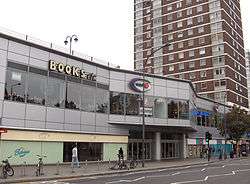 Shepherds Bush's West 12 Shopping Centre, north entrance.(September 2006)
Shepherds Bush's West 12 Shopping Centre, north entrance.(September 2006)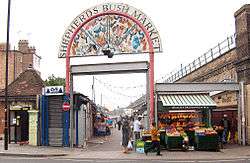 Shepherd's Bush Market, early morning, from the Uxbridge Road end. (September 2006)
Shepherd's Bush Market, early morning, from the Uxbridge Road end. (September 2006)- The new Shepherd's Bush Overground station, opened in 2008
 Westfield Shopping Centre
Westfield Shopping Centre- Goaloids by Artist Elliott Brook Shepherd's Bush Green (installed 2012)-Image- Lucian Evans -Leap Films
References
- ↑ West 12 Official Site Retrieved March 2012
- ↑ 18 September 2009 (2009-09-18). "Shepherds Bush attracts Zodiak | News - print". Property Week. Retrieved 2010-08-02.
- ↑ 26 February 2010 (2010-02-26). "Jellycat struts into Shepherds Bush | News - print". Property Week. Retrieved 2010-08-02.
- ↑ Escape Studios website Retrieved 2011
- ↑ Walks Around the Bush: Three Walks Looking at the Local History and Architecture of Shepherd's Bush (West London), Ivan Gibbons
- ↑ GCSE History of Shepherd's Bush Archived 26 April 2012 at the Wayback Machine. Retrieved July 2011
- ↑ Evinson, Denis, p.128, Catholic Churches of London Retrieved July 2011
- ↑ Bibe, p. 20, A Victim Retrieved July 2011
- ↑ Schreuders, Piet, p.141, Beatles London Retrieved July 2011
- ↑ London Borough of Hammersmith and Fulham. "Site Proposals - Site 36 White City Centre Site". Retrieved 2007-10-02.
- ↑ Sharpfibre Ltd. "Case study: White City". Archived from the original on 1 January 2008. Retrieved 2007-10-02.
- 1 2 The Worldwide Guide to Movie Locations. "Who Framed Roger Rabbit filming locations". Retrieved 2 October 2007.
- ↑ Private Eye (1195). 12 October 2007. p. 6. Missing or empty
|title=(help) - ↑ Barney, Katharine. "New railway station over budget...and undersized". Evening Standard. Archived from the original on 29 January 2008. Retrieved 12 October 2007.
- ↑ "Mayor of London and the leader of Ealing Council agree new solution to traffic congestion as deal on Crossrail approaches". 2 August 2007. Archived from the original on 9 July 2007. Retrieved 2 November 2007.
- ↑ http://hidden-london.com/gazetteer/shepherds-bush/
- ↑ Official Report of 1908 Olympiad, p.204 Retrieved August 2012
- ↑ "WG Pride Awards". digital-thisis.co.uk.
- ↑ "Sculpture is 'opening goal on journey' | This is Somerset". Archive.is. Archived from the original on 2013-10-10. Retrieved 2018-07-14.
- ↑ 2020 Official website Archived 29 July 2012 at the Wayback Machine. Retrieved December 2012
- ↑ "Shepherds Bush's Local Web site". Retrieved December 2011. Check date values in:
|accessdate=(help) - ↑ Shepherd's Bush Conservation Area Archived 11 December 2011 at the Wayback Machine. Retrieved December 2011
- ↑ www.andyslaughter.co.uk Retrieved March 2012
External links
- The Shepherd's Bush Blog Retrieved October 2014
- Shepherd's Bush Local Information Retrieved July 2011
- The Bush Theatre Retrieved July 2011
- Shepherds Bush Empire Retrieved July 2011
- Shepherds Bush Festival Retrieved July 2011
- History of Shepherd's Bush Retrieved July 2011
- Unofficial history of Lime Grove Studios Retrieved July 2011
- History of Gaumont-British and Lime Grove Studios Retrieved July 2011
